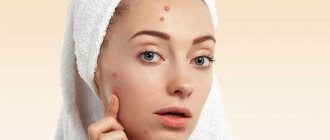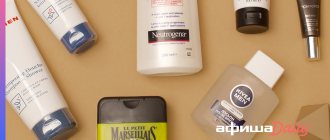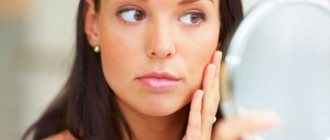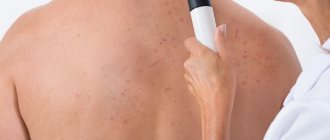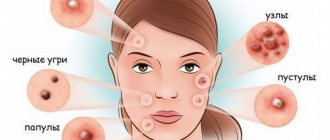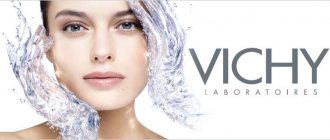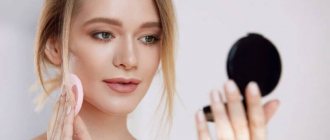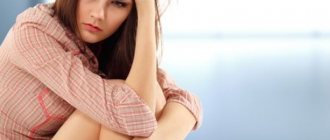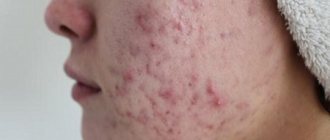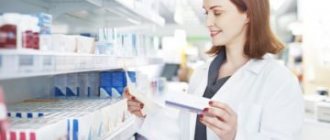Main causes of acne
When the sebaceous ducts and hair follicles become inflamed, dense plugs form. They block the natural regeneration of the skin, provoke inflammation and the appearance of rashes, pimples, and redness. Dermatologists call this epithelial disease “acne.” It is provoked by various factors and causes.
For a long time, doctors believed that rashes on the face, body and head appear when the rules of hygiene and skin cleansing are violated. In fact, acne is a dermatological disease that requires complex treatment with various methods and drugs. Among the main causes of inflammation:
- genetic predisposition;
- increased production of skin secretions;
- period of hormonal formation in adolescents;
- high levels of stress hormone in the blood;
- pathologies of the adrenal glands;
- disruption of the process of regeneration and keratinization of the epidermis;
- improper skin cleansing;
- taking hormonal drugs and anabolic steroids;
- ingestion of chemical compounds with lithium and halogens into the body;
- prolonged contact with chlorine;
- pathologies of the thyroid gland;
- avitaminosis;
- complications during antibiotic treatment and decreased immunity;
- bad habits;
- subcutaneous mite
In women, acne can be caused by the use of low-quality cosmetics with ingredients that close the pores. They cause increased sebum production. The secretion mixes with particles of the epidermis, causing inflammation and rash.
With dysbacteriosis and other intestinal diseases, acne appears due to intoxication. Constipation leads to the accumulation of feces, some of the toxins enter the bloodstream and disperse throughout the body. The rashes concentrate on the cheeks and chin, on the back, the sebaceous shine increases, and the condition of the skin worsens.
Mistakes when treating acne
The appearance of complications and ineffective long-term treatment most often occurs due to the fault of the person with acne symptoms. Picking and squeezing pimples, using inappropriate soaps and cleansers, and using folk remedies often leads to disastrous consequences.
Error No. 1: Do not complete treatment
The skin does not respond immediately to treatment. Intensive treatment, which leads to complete elimination of acne, lasts on average from 6 to 12 weeks. Sometimes, the first weeks of treatment may occur with irritation from medications and cosmetics.
Error No. 2: Try to treat acne with several drugs at the same time
A common situation is that people try to use many drugs and cosmetics at the same time, layering each other and abandoning those that do not give effect within 1-2 days. This approach to acne treatment can cause even greater complications.
Error No. 3: Over-scrubbing and excessive use of cleansers
Selecting and using scrubs for acne-prone skin must be done with great care, otherwise there is a risk of complications. Use cleansers without harsh active ingredients to restore pH balance and reduce irritation. It is also important to rinse off cleansers thoroughly, as residue can cause irritation.
It's important to remember that acne is not caused by dirt, so over-washing and scrubbing will not produce positive results.
Error No. 4: Choose the wrong products
Harsh cleansers, alkaline soaps, and cosmetics containing alcohol worsen acne-prone skin. Look for products that are labeled “non-comedogenic” or “for acne-prone skin.” Such products do not clog pores and do not irritate already irritated skin.
Error No. 5: Squeeze and pick pimples
Picking, squeezing, scratching and any other physical impact on acne prolongs the treatment course and increases the risk of scar formation. There is also a high chance of germs getting into the skin, which can lead to swelling and more serious problems.
Error No. 6: Do not consult doctors
The best way to eliminate acne on the face is to consult a dermatologist, who will identify skin problems and prescribe the necessary medications and cosmetics. Self-medication can lead to complications of the disease and delay the recovery process for a long time. In addition, acne can be confused with other skin ailments, for example, with rosacea (rosacea) - in this case, the treatment is very different.
Error No. 7: Stop treatment when relief occurs
Once remission occurs, people most often stop using anti-acne medications as scheduled or stop treatment completely. In this case, acne symptoms will return after a few weeks. It is necessary to complete the course of treatment prescribed by a specialist or at least the one recommended by the manufacturer of the drug you are using.
Types and forms of inflammation
When diagnosing, dermatologists divide acne into inflammatory and non-inflammatory rashes. The first form is the most problematic and requires in-depth diagnostics. It conventionally includes several types of acne:
- common in adolescence;
- conglobate with the formation of a purulent cyst;
- fulminant with inflammatory exudate, causing intoxication and deterioration of well-being;
- mechanical, arising from rubbing with seams, skin irritation.
The second non-inflammatory form includes black comedones. They appear due to the accumulation of skin secretions mixed with dust, keratinized particles, and dead epithelial cells. They do not require drug treatment and are removed mechanically.
Acne appears on the skin in several forms:
- acne;
- acne;
- papules;
- pustules;
- nodules;
- large cysts;
- white or black comedones.
Sometimes, in severe cases, different types of rash appear simultaneously, and the amount of sebaceous secretion changes.
Stages of acne development
The rashes are in most cases localized in the T-zone, covering the forehead, cheeks and chin. Depending on the severity of the disease, the number of acne and comedones, doctors distinguish several stages of development:
- First or easy. No more than 10 rashes appear on the face and body, the inflammatory process is practically not expressed.
- Second or middle degree. The number of pimples reaches 20 spots, the sebaceous glands are activated, the skin becomes rougher and looser.
- Third or heavy. At least 40 inflammatory elements and many black comedones appear on the face. The skin takes on a stale gray tint, and many purulent cysts are present.
- The fourth or extremely severe form. The amount of acne significantly exceeds 40 units, cystic elements cover the back and T-zone of the face. Intoxication of the body is observed, the skin becomes lumpy with large pores.
Classification by stages is necessary for the correct selection of medications and treatment methods. In severe cases, there is a higher risk of scarring after the rash.
Signs and symptoms of problem skin
Before deciding to use any non-drug treatment, it is important to identify the symptoms that are causing you concern. Products for problematic and acne-prone skin, as well as for the treatment of mild to moderate acne, usually solve one or more problems associated with the skin condition.
Acne: what happens in the skin
They act by:
- reducing sebum production, thereby controlling seborrhea;
- accelerating the exfoliation of skin cells, which helps fight hyperkeratosis;
- combating bacterial infection caused by the proliferation of microorganisms;
- reducing inflammation, which, in turn, will promote healing of the sebaceous gland.
Features of the course depending on age classification
It is a mistake to believe that acne occurs only in adolescents during puberty. Acne is an inflammation of the skin that occurs at any age and is equally intense in men and women. Conventionally, the disease is divided according to the age of the patients:
- Children's rashes. Often occur in the first weeks after birth if maternal hormones are present in the blood of newborns. They do not require treatment and resolve with proper and regular hygiene.
- Teenage acne. They occur to varying degrees in 80−90% of boys and girls under 16−17 years of age. Associated with the formation of hormonal levels, localized on the face.
- Late. Acne in adults is more likely a sign of diseases of internal organs and metabolic disorders. If you have such a symptom, it is recommended to visit a gynecologist, gastroenterologist and allergist.
Acne treatment is selected depending on the underlying cause of acne and the age of the patient. Children's rashes can be treated with non-hormonal ointments, light creams with natural ingredients. When bathing a baby in water, it is recommended to add a decoction of string or chamomile as an antiseptic.
Treatment of acne in adolescence involves the use of special zinc-based cosmetics with the addition of essential oils. At the pharmacy you can buy ointments that cleanse clogged pores and improve the outflow of skin secretions. Dermatologists recommend masks made from natural mud or clay, products with retinoids (Skinoren, Baziron AC, Intraskin).
When treating advanced acne, complex diagnostics is required. After identifying the cause, drug therapy for the underlying disease is carried out. In adulthood, skin regeneration is slowed down, so the help of a cosmetologist and procedures for polishing the top layer are necessary. Cosmetics with medicinal and moisturizing ingredients must be prescribed.
Comprehensive acne treatment
The choice of therapy method and medications is made by a dermatologist after a visual examination. If necessary, a blood test is prescribed and a scraping is taken from the surface of the skin to exclude mites or fungi.
Acne treatment depends on the type of rash:
- For acne, retinoids and preparations based on salicylic acid are prescribed.
- The mixed form of the disease responds better to treatment with retinoids, antibiotics and ointments with the addition of benzene peroxide.
- For acne in adulthood, gels with an antibacterial effect, macrolide and tetracycline antibiotics are prescribed.
- The complex cystic form requires the use of hormonal drugs in the form of tablets, treatment of diseases of the thyroid gland and adrenal glands. Oral contraceptives are more often prescribed to regulate the level of estrogens and gestagens.
On average, the course of acne treatment lasts from 1 to 3 months. You need to be patient: complete cleansing of the skin requires strict adherence to a diet and facial care with the help of medicinal products. Vitamins and proper nutrition accelerate the regeneration and restoration of collagen fibers.
Preparations for the treatment of acne
Depending on the form of the disease, the doctor selects means for external and oral use. Local medications must be prescribed that inhibit the growth of bacteria on the surface of the skin. They regulate secretion production, prevent secondary infections and hyperkeratosis. The best options for treating pimples and blackheads at any age:
- Zenerite. Contains the antibiotic erythromycin and zinc acetate. A dermatotropic agent suppresses the growth of pathogenic microflora, streptococci and propionic pathogens, recommended for seborrhea and oily skin types. The solution is effective at any stage of the disease.
- Klenzit-S. The combination ointment contains adapalene and clindamycin. This is a high-quality retinoid, identical to natural vitamin A. Quickly relieves acute inflammation, eliminates black and white comedones, opens and cleanses pores. The functioning of hair follicles improves. Apply once a day.
- Dalatsin. A gel based on the antibiotic clindamycin triggers the natural cleansing of the sebaceous glands, destroys bacteria, and reduces the oiliness of the epidermis. Among the disadvantages is that with long-term treatment it dries out the skin and can cause irritation.
- Baziron AS. Contains zinc, which eliminates strong discharge from the ducts, is a mild keratolytic, and removes keratinized particles. The gel improves tissue nutrition, triggers regeneration, and is effective for severe cystic acne. Safe during pregnancy and breastfeeding.
- Skinoren. The composition is based on azelaic acid. It is a dermatoprotector that inhibits the growth of microorganisms, improves the keratinization process, and reduces the intensity of fatty acid secretions. When used, it increases local immunity.
- Cynovitis. Anti-acne cream-gel contains zinc, climbazole, urea, vitamin A. Improves the condition of the epidermis, softens rough areas, stops inflammation. Dries out rashes and cystic acne.
- Differin. Acne gel with adapalene, which has properties similar to retinoic acid. Cleans sebaceous plugs and dissolves dirt. Changes the structure of epithelial cells, preventing infectious lesions. Promotes rapid regeneration.
Products with a hormonal component are used in severe stages only as prescribed by a doctor. They have a number of contraindications and must be dosed carefully according to the instructions.
For complex treatment of acne, doctors prescribe drugs in tablets. Drug therapy supports the body from the inside, eliminates the main cause of inflammation and metabolic disorders. The most common medications for rashes are:
- Hormonal contraceptives. They are selected individually after conducting a series of tests to determine the level of estrogen in the blood. The gynecologist may prescribe a course of the drug Yarina, Janine, Regulon.
- Antibiotics for bacterial skin infections with staphylococci or other types of bacteria. The following are considered effective for acne: Unidox Solutab, Tetracycline, Doxycycline, Erythromycin. They suppress the growth of pathogenic microflora during severe forms of the disease.
- Retinoids. The most effective drug in tablet form is Roaccutane based on isotretinoin. It is used only for stages 3-4 of the disease, it stimulates cleansing of the skin from the inside. It normalizes the functioning of the sebaceous glands and reduces secretions, which prevents the formation of new lesions. No less useful are the drugs Lokacid, Klenzit, Deriva.
With acne, painful pimples remain on the skin, which can heal poorly and become affected by a secondary bacterial infection. During treatment, doctors prescribe auxiliary gels and creams that improve the condition of the epidermis:
- Bepanten;
- salicylic ointment;
- Levomekol;
- zinc ointment;
- Boro Plus.
The last option can be used as a compress. The drug contains natural oils and extracts. It draws out inflammatory exudate well, disinfects acne wounds, and accelerates healing without scarring.
During acne treatment, it is recommended to take a multivitamin complex. It is necessary to maintain immunity and improve metabolism. The drug must necessarily contain retinol, tocopherol, niacin and ascorbic acid, B vitamins, zinc, magnesium. Omega-3 and Omega-6 amino acids are useful for skin regeneration.
Effective remedies from Asia
In the complex treatment of acne, drugs from Korean and Chinese doctors have proven themselves well. They are distinguished by a multicomponent composition with a large number of useful extracts, plant extracts, and essential oils. They have antiseptic, anti-inflammatory and healing properties, act gently, and prevent the appearance of scars.
Effective drugs from Asia:
- Trangala. Vietnamese acne ointment contains the antibiotic chloramphenicol, python fat, and dexamethasone. Relieves irritation of the epidermis and inflammation, improves nutrition and hydration of the skin, protects against various types of bacteria, and normalizes skin secretions. Heals damage caused by furunculosis, dermatophytosis, burns, urticaria. The composition is safe during pregnancy, lactation, and can be prescribed for acne in adolescents.
- Madame Heng Ozzy. Antibacterial acne lotion from a famous Thai brand is recommended for any stage of the disease. The antiseptic stops the proliferation of bacteria, heals, and stops inflammatory processes. It draws out pus from cystic rashes and prevents scarring. Contains tea tree oil and natural extracts to disinfect the epidermis.
- Miao Yao Qi Yang Jing acne cream. Prescribed for acne in adults and adolescents, suitable for sensitive skin. Contains extracts of yellow sophora, zhgun root, tuber stem, false larch, milkweed, and natural snake oil. Relieves swelling and redness, improves metabolic processes, saturates with vitamins, oxygen, amino acids. Heals open pimples and cysts, leaving the skin smooth without black comedones.
- Yoko Acne-Melasma Cream. An effective cream with antibacterial and whitening effects contains kojic acid, allantoin, and coenzyme Q10. The Thai remedy improves the condition of the skin with acne, melasma, and eliminates pigmentation. Prescribed in adolescence to smooth the epidermis and reduce the number of comedones.
- Zudaifu sulfur soap. Recommended for acne for daily hygiene, protection against bacteria. Sulfur penetrates the pores, cleanses them from the inside of skin secretions and keratinized particles. Can be used as a mask, leaving the foam on the face for 5 minutes. Aloe and olive oil nourish, moisturize, smooth the epidermis, and restore a healthy tone.
- Sulfur soap for face and body. The main component is sulfur, which is effective against bacteria and microbes, reduces fat, heals suppuration and pustules. Palm and olive oil improve the condition of the epidermis, narrow pores, and normalize secretion production. Aloe rejuvenates, nourishes and moisturizes, supports regeneration, reducing the risk of scar formation.
Products from Asian pharmacologists may contain hormonal components and antibiotics. Therefore, before use, you must carefully study the composition and apply a small amount of cream or lotion to the skin of your hand. They can be combined with other drugs and used to prevent acne in adolescents.
Cosmetology procedures
Problematic acne skin requires special care. If hygiene is improper, the situation can worsen significantly and secondary infection occurs. Removing acne and pustules on your own often leaves scars and makes the epidermis lumpy and rough.
In addition to drug treatment for acne, dermatologists recommend physical therapy and special procedures. They stimulate the sebaceous glands and help ointments and creams penetrate into the deep layers of the dermis. The following methods of hardware therapy are most useful for acne:
- Laser treatment. Eliminates pigmentation after healing, dissolves sebaceous plugs, accelerates healing and cleansing. Prescribed for cystic and pustular acne, large comedones, stimulates the production of collagen fibers.
- Light therapy. Waves of a certain range suppress the growth of bacteria, increase the content of intracellular oxygen, vitamins and minerals. The functioning of the sebaceous glands is normalized, wounds heal quickly and without consequences.
- Ozone therapy. A mixture based on ozone and oxygen is injected under the inflamed skin. The procedure stops the progression of the disease, stimulates blood flow, and reduces redness. The result appears after 5-8 sessions and lasts for more than a year.
- Darsonval. Effects of alternating current are indicated for acne, enlarged pores, and blackheads. Prescribed for severe forms, tones capillaries, removes toxins, heals inflamed and purulent pustules.
For acne, cosmetic peels are often prescribed. They remove the top layer of skin and dead cells. This increases the flow of oxygen and restores blood circulation. After use, no traces remain, and the epidermis looks smooth, even, and acquires a natural healthy tone.
Cosmetologists recommend the following types of peeling:
- Superficial for acne with minimal impact on the skin.
- Median after recovery to improve relief and prevent inflammation.
- Acid exfoliation at different stages of the disease to reduce rashes and complications.
To remove cystic and pustular formations, glycolic, salicylic, lactic or ascorbic acid is used. In each case, the cosmetologist selects the medications individually, and pre-conducts allergy tests. After the procedure, the doctor explains how to properly care for problem skin and prescribes products for washing and cleansing at home.
Elimination of inflammation
One of the main causes of acne is the penetration of acne bacteria into the ducts of the sebaceous glands. Their active activity causes an inflammatory reaction in the body - this is how purulent acne appears. Therefore, caring for skin with acne requires the mandatory use of products that contain components with the following properties:
- antibacterial and soothing - zinc, essential oils of chamomile, shea and lavender, extracts of calendula, St. John's wort, aloe, etc.;
- anti-inflammatory and antiseptic – zinc derivatives; fruit acids, vitamin A-aldehyde;
- sebum-regulating (see paragraph “Proper cleansing”);
- exfoliating – primarily fruit acids; regenerating – tocopherol (vitamin E), hyaluronic acid.
Cosmetics from many manufacturers contain similar components: creams Vichy, Ducray, Bioderma, Delex Acne, etc. Alcohol-free lotions with extracts of aloe, chamomile, and menthol cope well with inflammation and irritation.
Proper care for problematic facial skin excludes the use of alcohol-containing components and scrubs. Their irritating effect on the sebaceous glands provokes hypersecretion and excessive production of sebum (fat).
Treatment of acne with traditional methods
For mild acne or teenage acne, you can treat the problem at home. There are many folk recipes made from natural ingredients that are safe for health. For greater effectiveness, doctors recommend using them as an addition to drug therapy.
Fruits and vegetables contain acids that stimulate skin cleansing, soothe and normalize oil production. The best and time-tested recipes:
- Grind a green apple into a pulp with a blender, add a spoonful of yogurt or kefir, and a little liquid honey. Apply every other day as a mask for 20 minutes to nourish and cleanse.
- Finely grate the carrots and mix with a spoonful of fresh lemon juice. Use 2 times a week for dry, dehydrated skin.
- In case of moderate severity, the inflamed areas can be lubricated with aloe juice, or green leaf pulp can be applied to the cysts.
- To reduce fat content and lighten comedones, grate 2 cucumbers, add 200 ml of alcohol, leave for a week. Wipe painful areas 2 times a day.
After washing, in case of exacerbation of acne, it is recommended to rinse the skin with a decoction of chamomile, string, celandine, horsetail, and wormwood. Acne can be wiped with a pharmacy tincture of calendula or propolis.
Baking soda can help get rid of acne at home. It is mixed with kefir to a thick paste, applied to areas affected by acne for 15 minutes. For dry skin types, replace the fermented milk drink with clean water. This composition cleanses pores, brightens comedones, and reduces the activity of glands.
Care for oily skin at home
Home remedies work no worse than expensive store-bought ones. And their additional advantage is that a person knows exactly what is in the composition. High-quality ingredients guarantee excellent care for oily skin at home. You can make soap, make scrubs, masks, tonics and lotions.
Homemade Soap Recipes
Any soap contains a special base and additional ingredients. Soap making has become a fashionable hobby, and home-made products make excellent gifts. Sometimes regular unscented baby soap is dissolved as a base. Herbal extracts, oils (for example, rose), and ethers are added to the finished mass. Everything is thoroughly mixed, poured into molds and the mass hardens. Now you can use it. Sometimes scrubbing agents are added to soap. The best formulations contain citrus zest, oatmeal, ground into flour, and other ingredients.
Effective homemade scrubs for oily skin
Any scrub consists of small solid particles and a base that binds them. The latter is honey, clay, fermented milk products, for example, low-fat sour cream. And as an abrasive, soda, coffee grounds, sea salt, and cane sugar are used. The clay is diluted with warm water and exfoliating particles are added to it; sometimes a gel or foam for washing is used as a base. Do not apply such care products to oily skin if it is damaged or inflamed.
Homemade tonics
Toning lotions can also be made at home. The easiest option is to dilute the herbal infusion with alcohol in equal parts. The resulting tonic is used to wipe the face after washing. You can also make products to care for oily skin without alcohol, but they will have to be stored in the refrigerator. Some products in themselves are an excellent tonic; for example, you can wipe your face with lemon juice without any additives. Herbs used include chamomile, St. John's wort, wormwood and others.
Mask recipes for oily skin
Masks have a good effect on sebum secretion, are anti-inflammatory and cleansing. In addition, they eliminate other problems when caring for an oily face, such as wrinkles. You can limit yourself to one ingredient (strawberry pulp, kiwi), but it is better to choose components that successfully complement each other. The most popular homemade masks are as follows:
- Kefir (sour cream, yogurt) + banana pulp. Fermented milk products should be chosen natural and low-fat;
- Egg white with lemon juice. Has an excellent whitening and drying effect. And protein gives pore closure and a lifting effect;
- Yeast with kefir and honey. The face will be smooth and well-groomed.
They are prepared in the same way - all ingredients are thoroughly mixed (the egg white and juice are whipped until foamy) and applied to cleansed facial skin. Yeast is diluted in warm water and left for 15-20 minutes and only then everything else is added. Makeup is first removed from the face, masks are applied after washing and applying lotion. The optimal time for the mask to work is 20-30 minutes, then it should be washed off and the appropriate cream should be applied.
If you want to remove oily shine from your face, we advise you to look at the recipe for the most effective mask!
Homemade creams
They must be stored in the refrigerator, because there are no preservatives in natural cream. Ingredients: active substance, emulsifier, herbal decoction, base and essential oils, vitamins. Base oil (olive, wheat germ, grape seed, peach) should be heated in a water bath, add an emulsifier (sucrose stearate) and a decoction of herbs. Then cool and add the active substance (for example, yeast) and essential oil. The cream should definitely be tested on the crook of the elbow for an allergic reaction. You can also use pure oil - rose, jojoba and others, but not often. Caring for oily skin in winter differs from summer - this should be remembered. You can add beeswax to winter cream.
Diet for acne
Proper nutrition is one of the methods for treating acne, which complements drug therapy and physiotherapy. When the intestines are fully functioning, toxins that affect the skin from the inside are eliminated faster. The body receives more vitamins for complete cell regeneration.
Some products activate the sebaceous glands and secretion production. Therefore, for severe rashes, doctors recommend following the following diet:
- Remove simple carbohydrates in the form of sweets, baked goods, sugar, carbonated drinks, chocolate.
- Do not eat foods with a high glycemic index (honey, sweet fruits, cakes, sweets, some cereals).
- Completely avoid alcohol, store-bought sauces, margarine, hot spices and exotic seasonings.
- Prepare dishes by stewing or baking in their own juices without oil or fat.
Improves skin condition by consuming natural foods with a lot of fiber: fruits, legumes, vegetables, cereals. They accelerate intestinal motility, restore immunity and beneficial microflora. Constipation disappears, the intensity of sebum production decreases.
For acne, it is recommended to include sea fish, natural vegetable oil, nuts, and sprouted grains in your menu every day. Meat should be chosen from low-fat varieties, and preference is given to poultry. It is useful to drink fermented milk drinks, eat cottage cheese, and drink more clean water.
Professional care for oily skin in the salon
Peels work great. It is in the salon that you can make medium and deep options, but only in the cold season. One of the popular procedures is mechanical facial cleansing. Professional care also includes phototherapy, which helps remove scars and acne marks. Cosmetologists advise taking a course of biodermabrasion. With the help of some manipulations, the skin is cleansed, especially since this procedure is not at all traumatic.
A more complex and effective treatment is a fractional laser cleaning session. And of course, in any salon you can get advice and recommendations from professional cosmetologists that are worth following.
Fighting the effects of acne
After treatment of rashes and severe forms of the disease, red spots or pigmentation and protruding keloid scars may remain on the skin. They spoil your appearance and deprive you of your confidence in attractiveness. These are cosmetic defects that do not go away on their own.
Experts recommend several methods for cleansing and restoring skin smoothness:
- Creams and masks with alpha hydroxy acids, peptides, vitamins and whitening pigments.
- A course of peelings based on lactic acid.
- Dermabrasion with exfoliation of the upper layer of the dermis.
- Laser resurfacing of scars.
After treatment, the skin takes up to 3 weeks to fully regenerate. At this time, you should use a special cream with a high level of sun protection, take vitamins, and eat right. The procedure must be performed by an experienced dermatologist-cosmetologist who uses only certified drugs.
How to treat problem skin?
Treatment for moderate to severe acne may require medical intervention from a doctor or dermatologist, but moderate acne can usually be treated without medication.
Pharmacies offer a wide range of products for cosmetic skin care, in particular:
- Topical antibacterials, such as decanediol, which can kill bacteria
- Licochalcone A, an effective anti-inflammatory agent
- Carnitine, which reduces sebum production
- Lactic acid as a keratolytic agent.
They can be used on any affected area: face, shoulders, chest or back. These products can also be used as a complement to standard drug treatments to prevent side effects such as dry skin or sun sensitivity.
For acne-prone skin, regular cleansing is recommended. A healthy diet and lifestyle contribute to healthy skin.
In addition to the creams and gels that are used to treat the symptoms of acne-prone skin, there are also products that can help mask the unwanted effects.
For example, non-comedogenic makeup can be used to cover up acne on the face, but it is important to remove it at the end of the day with a gentle cleanser. Men can also use concealer makeup to hide redness and even out their complexion. Foundations can be applied locally on small affected areas.
Contrary to myth, neither toothpastes nor aspirin masks are effective in drying out acne. There is no medical evidence for this, and in fact, it can be harmful. Toothpaste contains substances that can irritate and damage the skin.
It's also always wise to eat healthy, stay away from places where your skin is exposed to smoke or dirt, and, given the psychological effects of problem skin, do everything you can to boost your self-esteem and confidence.
Frequently asked questions about acne
Acne occurs in 25-30% of people at different ages. This disease brings a lot of unpleasant moments to a person. It does not provoke complications in internal organs, but becomes a cause of neurosis, stress, isolation and refusal of personal relationships.
What to do first when acne appears?
If a rash appears on the face and body, you should reconsider your diet and avoid unhealthy and fatty foods. Adult patients need to see a gynecologist, gastroenterologist or therapist to rule out hormonal imbalance. It is better not to self-medicate, consult a dermatologist, choose medicinal cosmetics and medications.
How to prevent recurrent rashes?
The main method of prevention is the treatment of chronic diseases, dysbiosis, constipation and thyroid diseases. It is necessary to get rid of bad habits, give up allergenic foods, and reduce the consumption of sweets and baked goods. It is important to maintain good hygiene and have a personal towel for your face and body.
Is it possible to cure acne once and for all?
Juvenile acne responds well to treatment and goes away completely after normalization of hormonal levels. But skin inflammation in adulthood is an important symptom of internal disorders and diseases. Therefore, you can get rid of acne forever only by eliminating the root cause and regular prevention.
The most common mistakes in care
People suffering from acne strive to get rid of the disease in various ways, but excessive care in some cases can have the completely opposite effect.
What not to do if you have acne:
- Squeezing pimples risks spreading the infection into the deeper layers of the dermis and increasing inflammation. Mechanical impact is the cause of premature aging and the appearance of scarring and stagnant spots.
- Overdry - the use of alcohol preparations or excessive prolonged exposure to the sun dries out the skin, which the sebaceous glands perceive as a danger. Since one of their functions is hydration, they begin to produce more sebum and as a result, even more acne appears.
- Using cosmetics that are not suitable for your skin type can result in overdrying and the absence of any results from it.
- Using decorative cosmetics during the treatment period clogs the pores and leads to the formation of comedones, which become inflamed and turn into purulent acne. If it is impossible to refuse makeup, you should use products labeled “non comedogenic” (not comedogenic).
Acne is a chronic disease that requires long-term and complex treatment. Cosmetic care (acne toilet) is one of the blocks of therapy, and it must also receive the approval of a dermatologist or cosmetologist in order to be effective.
